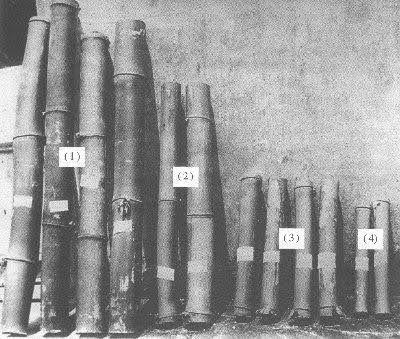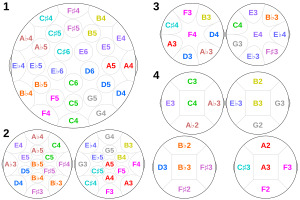History and the Synestone
Steel Pans - 1700-1951
-
The SP was created in Trinidad and Tobago in the mid 20th Century
- Namely from groups playing the Tamboo Bamboo, a precursor to the instrument that was made out of bamboo and was a basic idiophone (i.e. an instrument that produces sound by vibrating itself)
- There are four versions of the instrument:
- Boom: the bass, played by hitting a 5 foot bamboo pole on the ground
- Foule: the tenor, two pieces of bamboo each about a foot long, struck against each other
- Cutter: the highest pitch/soprano, made from a thin strip of bamboo and struck with a smaller bamboo pole
- Chandler: the alto sound, made from a slightly thicker strip of bamboo, like the Cutter but slightly thicker

-
The roots go back much earlier including to the Talking Drum from W. Africa
- These drums were basically used for communication based on rhythm and pitch and often communicated about information about gatherings of people especially around music, song, and dance…
-
In the 1700 and 1800s, as the French colonized TandT which led to them essentially mocking their slaves by aimlessly banding on drums, and undermining their customs
- In response, slaves organized their own Carnivals (in their own spaces to the degree that it was possible) which allowed them to celebrate their traditions including creating masks, and, notably, drumming
-
In 1789, the Spanish governor of Trinidad, Jose Maria Chacon, made a directive that all Africans would observe Roman Catholicism including all holy days of Christianity
- In an attempt to have some resistance to this, many enslaved people celebrated Christian holy days in ways that continued their traditions where possible
- For example, many people celebrated Sunday’s holy day by dancing and singing using traditional instruments and tunes
-
In 1789, the Spanish governor of Trinidad, Jose Maria Chacon, made a directive that all Africans would observe Roman Catholicism including all holy days of Christianity
- Eventually, this led to Canboulay (from the French cannes brulées, meaning burnt cane), a sort of proto-Carnival. Originally a harvest festival, at which drums, singing, dancing and chanting were an integral part, after Emancipation (1834), it developed into an outlet and a festival for former indentured laborers and freed slaves who were banned from participating in the celebrations aforementioned (i.e. European Carnivals/mockery sessions). This was especially momentous because those traditional drum and religious observances were also outlawed in the late 19th century.
-
In 1881, the Canboulay riots were essentially a reaction to the police’s actions during during Canboulay
- Another colonial powermove, the government, through police, tried to exercise power to stop revelers for Carnival who were making music and dancing in the streets
- Resisting this attempt to silence them, many people turned on the police and a fight broke out between the Canboulay band/Drummers and the police
- After a police officer was injured, by a rock, they open fired on the crowed, killing at least one young person and seriously wounding two others (although more casualties are likely)
- Later, in 1884, the colonial government passed the Peace Preservation Act, which prohibited the public from carrying torches, from drumming, blowing horns, and assembling groups of more than 10 people with drumming sticks (yet another colonial oppressive measure)
- This directly led to people playing the Tamboo Bamboo aforementioned
- By 1930, the legacy of the Tamboo Bamboo had transformed into the Steel Pan
- In 1937, the Steel Pan appeared in Laventille, originally an orchestral organization of fryingpans, dustbin lids, and, importantly, oil drums
-
In 1941, the U.S. Navy established a presence in TandT
- The pan players (or pannists) popularized this music amongst the U.S. Sailors which prompted the music’s international spread
- 1951, the Trinidad All-Steel Pan Percussion Orchestra (TASPO) was the first steelband whose instruments were all made from steel pans recognized on the international stage at the Festival of Britain (1951). This helped to continue it’s international spread
- The SP is created based around the Circle of Fifths, which allows for an intuitive and easy to understand design that creates a visual relationship between position and notes
